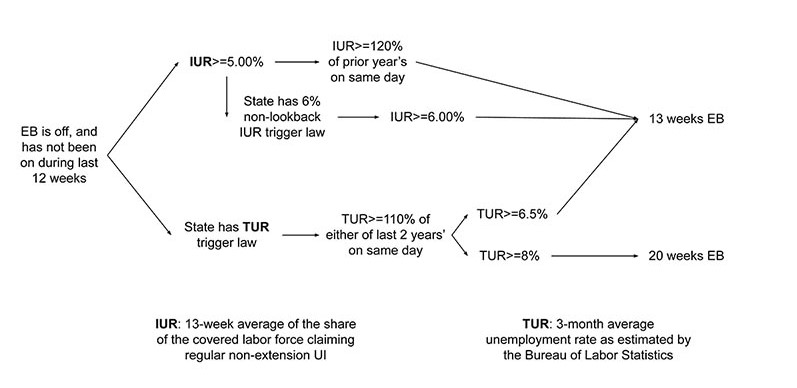
Background: The COVID-19 crisis has led to historically unprecedented increases in the level of initial Unemployment Insurance (UI) claims filed in California since the start of the crisis in mid-March. Through a partnership with the Labor Market Information Division of the California Employment Development Department, the California Policy Lab is analyzing daily initial UI claims to provide an in-depth and near real-time look at how the COVID-19 crisis is impacting various industries, regions, counties, and types of workers throughout California.
The Policy Briefs are updated on a monthly basis.
Return to the main report page to see all of the policy briefs, data points, and media coverage.
A Narrow Measure of Unemployment Is Cutting Short Extended UI Benefits for Workers Across The Country
Published April 20, 2021
By
Overview
The Extended Benefits (EB) program automatically extends how long a person can claim Unemployment Insurance (UI) benefits when the share of workers claiming regular UI benefits reaches a certain level. However, a key measure of unemployment through which EB triggers on and off does not count individuals receiving benefits through extension programs, such as Pandemic Emergency Unemployment Compensation (PEUC) or EB. As a result, when a large share of unemployed workers transition from regular UI to extension programs, EB can mechanically trigger off, even if the total number of UI claimants remains unchanged or is increasing.
POLICY BRIEF: Why Extended UI Benefits were Turned Off Prematurely for Workers in 33 States ![]()
PRESS RELEASE: Report: Extended Unemployment Benefits Are Being “Turned Off” Because Outdated Rules Don’t Count All Unemployed Workers
APPENDIX: State Level Appendix of Extended Benefits ![]()
Key Research Findings
1. In 33 states and territories, EB has triggered off earlier than it would have if the measure included the full set of regular UI claimants, affecting an estimated 300,000 workers.
2. Each state has an official IUR measure, which determines when Extended Benefits trigger on and off. CPL created alternative IUR measures which account for extension claimants. The difference between these two measures depends on how many claimants in the state have transitioned to extension programs.
Example A: In Minnesota, EB turned off on December 19, 2020. However, if the IUR measure included claimants on extension programs, EB would still be on in the state today.
Example B: In Virginia, EB turned off shortly after IUR crossed the 5% threshold on November 15th, 2020. However, if the IUR measure included extension claimants, it would not have crossed the threshold until January 10, 2021. In effect, workers in Virginia lost 8 weeks of extended benefits eligibility due to the IUR measure.
3. Extended Benefits can also become available through the optional TUR trigger. Currently, 5 states meet the threshold TUR threshold for Extended Benefits, but do not have TUR laws in effect – despite the fact that the federal government would pay 100% of the cost for these benefits until September 2021.
4. In California, the IUR measure has already dropped below the trigger threshold. However, the state is currently eligible for 20 weeks of Extended Benefits via the TUR measure. Once this measure (at 8.9% as of March 21, 2021) falls below 8.0%, Extended Benefits will only be available for 13 weeks in the state. When the measure drops below 6.5%, Extended Benefits will trigger off in California.
5. There are two types of economic triggers that can cause a state’s Extended Benefits period to turn on or off. The first trigger, used in all states, is the Insured Unemployment Rate (IUR) trigger. The second type of EB trigger is the Total Unemployment Rate (TUR) trigger.

Notes: This graphic depicts the ways in which an EB period can trigger on for a state. Possible scenarios in which IUR and TUR do not satisfy the EB trigger conditions are not illustrated.
